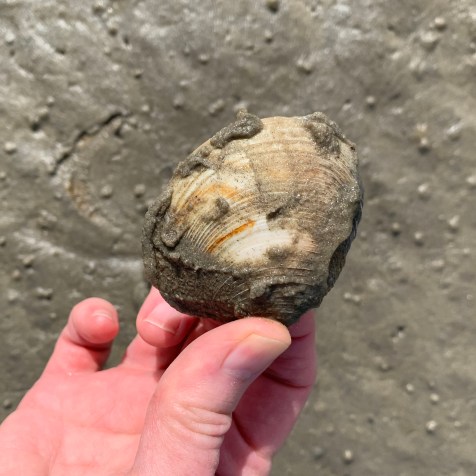Once we finished up at our first stop (read that post here), we boated up to Three Sisters which is a small group of mangrove islands in the backwater area of the Indian River. The tide was going out, which is my favorite time to beach-comb. We parked in behind the island and I searched for something to photograph.
Once again, as on the first stop of our boating trip, there were no larger shells and no hermit crabs. The tide was low and going out and the water was clear. Without a closer look, this area seemed to contain mud only and a few birds.
I thought the bird tracks were cool, and the other tracks may have been some kind of crab, but I’m not sure. There were holes in the sand so I suspect that crabs had dug them. I find this low tide landscape interesting, but much more so in the warmer months when living things are everywhere!
What I found was loads of very small sea snails. After finding the sand collar on my first stop, and now loads of “baby” sea snails, I’ve concluded that this is the time of year for babies to hatch. However, I have no idea where all the hermit crabs and larger snails have gone.
One of the little tide pools was teaming with life. All the tiny snails were mostly covered in mud and slowly wandering around. I carefully scooped one into a clam shell I found to take the video above. They looked like little clumps of mud. I cleaned the mud off to get the photo showing the actual tiny shell.

Babies or Simply Tiny Sea Snails?
As you can see, the tiny snail below looks different from the one above. Juvenile sea snails are hard for me to identify. All I can go by is what type of gastropods I usually find in this area – horse conchs (according to others it is bright orange as a baby), crown conchs, lightning whelks (opening on the left) and pear whelks. To a much lesser extent I see knobbed whelks, tulip shells, and have a few broken channeled whelks – usually shells only.
Because of the wide dark and light stripes on the shell below, I would guess it’s a baby crown conch. The shell above, no clue. Maybe it’s just a small snail and not a juvenile, but because there were so many tiny shells all together I was thinking that they “hatched” recently. I found no type of egg casing, but that could easily have washed away with the tide. I’m pretty much admitting that I just don’t know!


I did find one buried Southern quahog clam shell. I carefully dug at it to see if it was alive, but only one part of the clam was there, so I took it home.



All this photo sharing and research on juvenile snails has my brain hurting, so I am signing off for now. What I do know is that these backwater areas look very different (shell-wise) during the winter season.
If you haven’t read the first part of this story, check it out here.









The when-is-it-a-baby/or just-small question is a good one. I guess it would depend on how long it had been around! That’s no answer at all, I know!